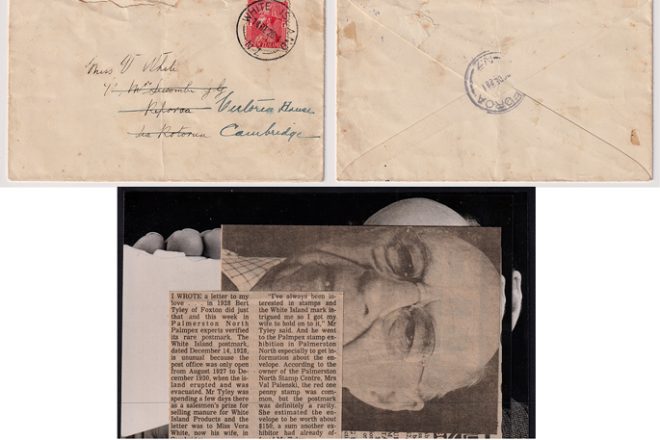Một phong bì được gửi từ Whakaari/Đảo Trắng đến Cambridge vào ngày 14 tháng 12 năm 1928, đang được bán đấu giá và dự kiến sẽ có giá khoảng 650 đô la. Phong bì là duy nhất do có dấu bưu điện từ Đảo Trắng, vì bưu điện trên đảo chỉ hoạt động từ năm 1927 đến năm 1930, khiến các bức thư từ đó khá hiếm. Bưu điện buộc phải đóng cửa khi khai thác lưu huỳnh, mà nó hỗ trợ, trở nên không có lợi trong cuộc suy thoái những năm 1930.
Phong bì này là một phần của cuộc đấu giá lớn hơn bao gồm một số phiên đấu giá tiền xu quan trọng nhất của New Zealand, dự kiến diễn ra tại Wellington vào tuần tới. Các cuộc đấu giá, bao gồm tiền xu và tem trị giá 1,7 triệu đô la, dự kiến sẽ đưa tổng doanh thu trong năm lên mức kỷ lục 3 triệu đô la. David Galt, giám đốc điều hành mới được bổ nhiệm gần đây của Mowbray Collectables, cho biết những con tem hiếm được cung cấp hầu như không bao giờ được nhìn thấy.
Trong số các mặt hàng được bán có một con tem Mười hai Shilling và Sixpence năm 1925, được sử dụng để nộp thuế tem và có hình ảnh của Nữ hoàng Victoria, ước tính có giá 75.000 đô la. Một con tem Threepence 1949, kỷ niệm chuyến thăm bị hủy của ông nội của Vua Charles, George VI, đến New Zealand, dự kiến sẽ được bán với giá 65.000 đô la.
Đồng xu ước tính hàng đầu là 18.000 đô la cho một bộ sáu đồng xu New Zealand từ năm 1935, bao gồm đồng xu quý hiếm của Vương miện Waitangi. Tờ tiền có giá trị nhất là tờ tiền ngân hàng dự trữ 50 pound từ năm 1934, cũng có Tamati Waka Nene, ước tính khoảng 20.000 đô la.
Các mặt hàng khác bao gồm đồng xu bị mắc kẹt trên báo chí và hiển thị hai đầu, và hai đồng xu “la” kết hợp các thiết kế đầu từ các quốc gia khác nhau với thiết kế của New Zealand. Ngoài ra còn có tám huy chương từ các cuộc Chiến tranh New Zealand năm 1860 và tám thánh giá tưởng niệm được cấp cho các gia đình New Zealand của những người lính thiệt mạng trong Thế chiến II trở đi. Những món đồ này đóng vai trò như một lời nhắc nhở mạnh mẽ về sự hy sinh của những người phục vụ ở nước ngoài, đặc biệt là khi Ngày ANZAC đến gần vào tháng Tư.





























































